Aviation book

| Note: | Images of the original pages are available through Internet Archive. See https://archive.org/details/aviationbook00davi |

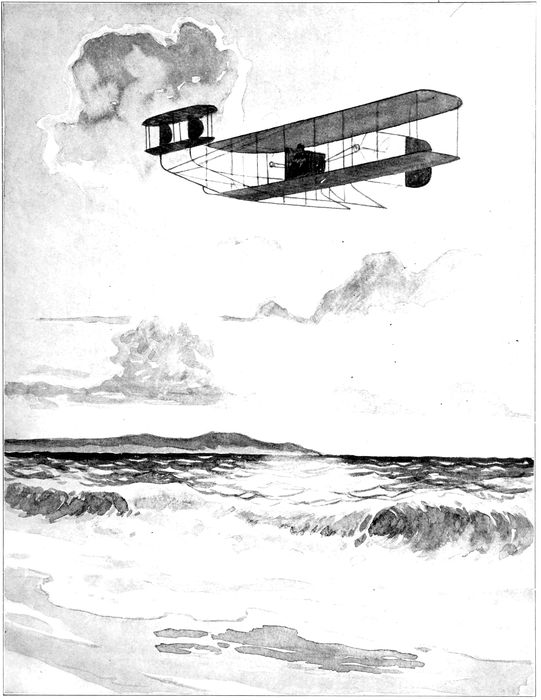
ORIGINAL WRIGHT BIPLANE. INVENTED AND FLOWN BY WRIGHT BROTHERS IN 1905 AT KITTY HAWK, N. C.
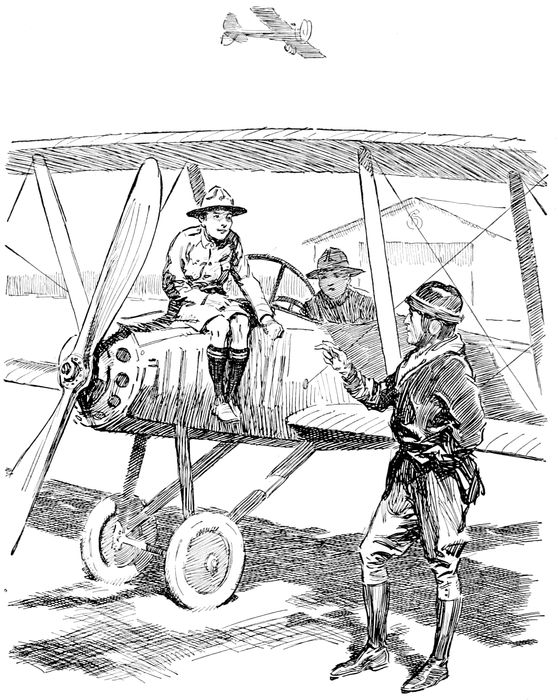
UNCLE SAM STARTS HIS AVIATION STORY
Tom and Jack are brothers and chums. They are Boy Scouts. Jack is first class, but Tom is only a tenderfoot. Like all bright, manly boys they are interested in airships and are anxious for the time to come when they can fly too.
Tom and Jack’s uncle is a famous aviator, and he knows all about flying. His name being Samuel the boys always call him Uncle Sam, and they sometimes jokingly pretend to think that he is the great Uncle Sam who represents the United States.
Tom and Jack knew that the best way to find out about airships was to ask their Uncle Sam. So, as soon as they saw him, they made him consent to tell his wonderful story of aviation.
Tom and Jack were all ears as their uncle started his aviation story.
“First,” he began, “I shall tell you the thrilling tale of Man’s long striving to learn how to rival the birds. In myths and fairy tales there were men and goblins who had wings or who owned winged chariots and animals. But real, everyday people never learned how to go up in the air until 1783.”
“The very year England and the United States made peace after the Revolutionary War!” exclaimed Tom.
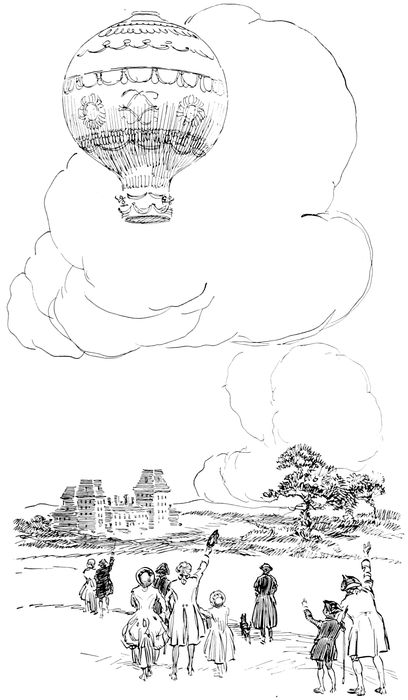
THE ASCENSION OF MONTGOLFIER’S BALLOON
“Don’t interrupt Uncle Sam; it is not polite,” advised Jack.
“Well,” continued Uncle Sam, “it was on June 5, 1783 that Stephen and Joseph Montgolfier, two French brothers, sent up the first balloon. You can just imagine the amazement it caused when it arose from the ground.
“Many successful experiments were made with balloons; but they were harder to run than old-time sailboats. A balloon could not fly against the wind. In a storm or a heavy gale it would be wrecked and the passengers killed. A machine was needed that could speed against the wind and not upset in a heavy blow.
“A few inventors tried to solve the flying problem with motor-driven balloons such as the German Zeppelin. But most attention was given to heavier-than-air machines known as aeroplanes. Aeroplanes are called heavier-than-air to distinguish them from balloons, which, being inflated with gas, are lighter than air. There were many discouraging years of hard thought and labor before success came. Finally, in 1905, two American brothers, Wilbur and Orville Wright, invented the first successful flying machine; and in a series of marvelous flights showed that Man had, at last, rivaled the birds.
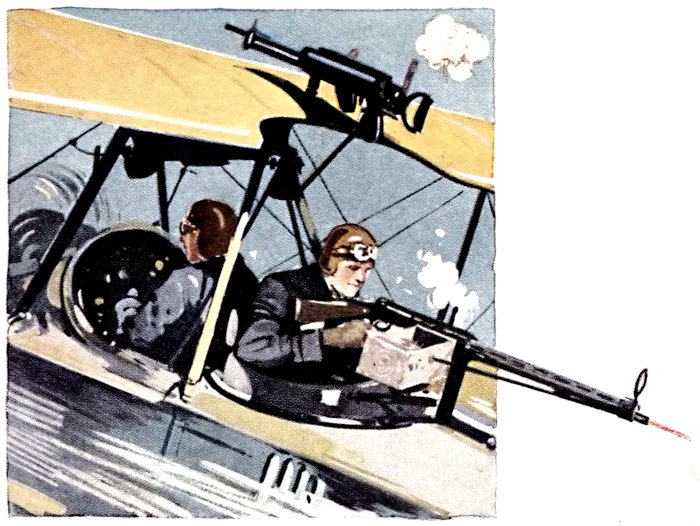
“Numerous inventions have made man almost the equal of the birds in the air. Flying has been made nearly as safe as riding on horseback or in an automobile. The aeroplane is now a necessity in times of war and peace. Its startling deeds will be the subject of the story I’m about to tell.
“Of course, you want to know something about the man who runs an aeroplane,” said Uncle Sam.
“Indeed, we do,” replied both boys at the same time.

THE AEROPLANE IS A NECESSITY IN TIMES OF WAR AND PEACE
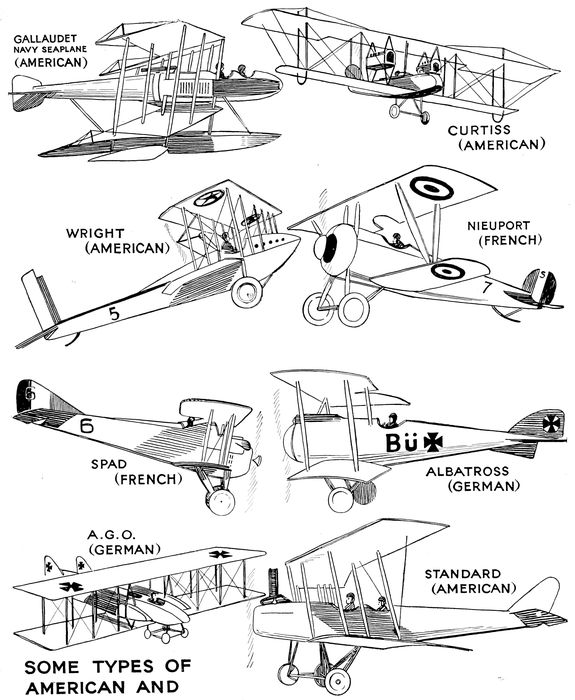
SOME TYPES OF AMERICAN AND FOREIGN AEROPLANES

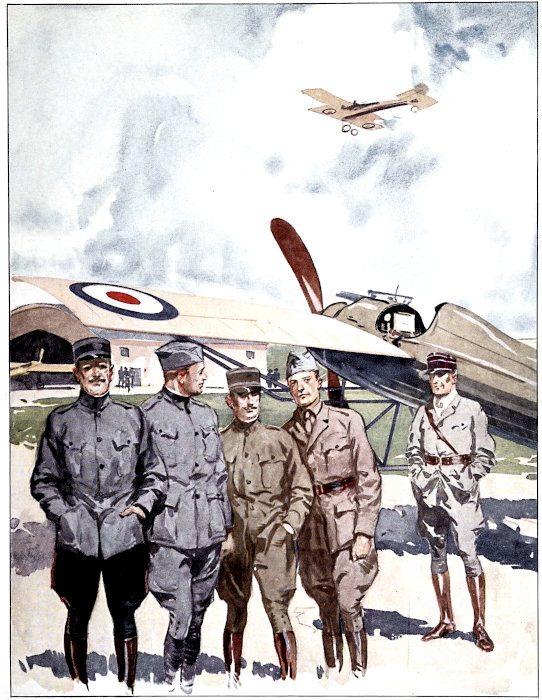
GROUP OF FRENCH AVIATORS
“Now,” continued Uncle Sam, “to become a military aviator a man must, first of all, have a strong, healthy body, a quick, active mind, and iron nerves. There are many good aviators that wouldn’t be good military aviators, because the strain of war would prove too much for them. If a man is just right in body and mind, they send him to an aviation training camp where he is taught to fly.
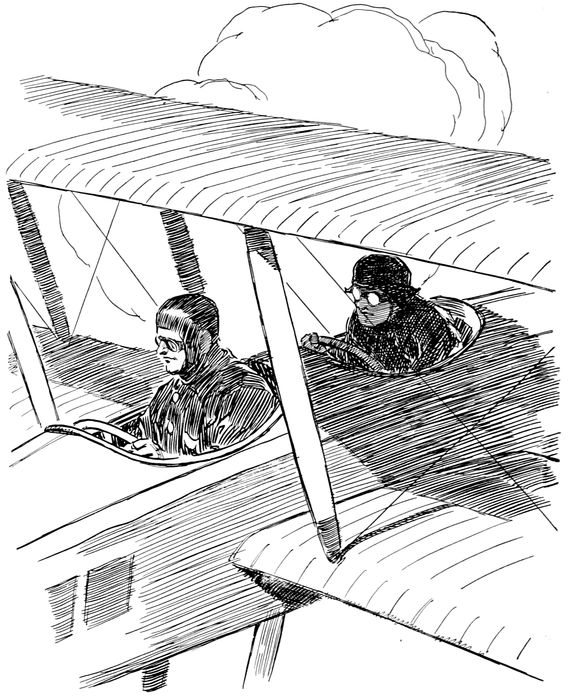
LEARNING TO FLY BY WATCHING THE EXPERT AVIATOR
“At the training camp he is instructed in the care of an aeroplane and its powerful motor. He goes up in the air a number of times with an expert aviator. By constantly watching the expert, he learns to fly. Then he learns many dazzling stunts—to loop-the-loop, make figure eights, fly upside down, and other dangerous maneuvers.
“After the new aviator knows how to care for an aeroplane and fly perfectly, he is taught wireless telegraphy, and shown how to take aerial photographs, fire machine guns and drop bombs. As soon as he learns all these things, he’s a full-fledged aviator, and ready to go into active service for his country.”
Tom and Jack had their eyes wide open in wonder as Uncle Sam continued:
“Ordinary flying, as I told you boys before, is now almost as safe as riding on horseback or in an auto. But, in time of war, running a military aeroplane is the riskiest work in the world. When I tell you of the marvelous, death-defying deeds military aviators have done, I doubt if you will believe me. Yet everything is absolutely true.

AEROPLANE DIRECTING ARTILLERY FIRE
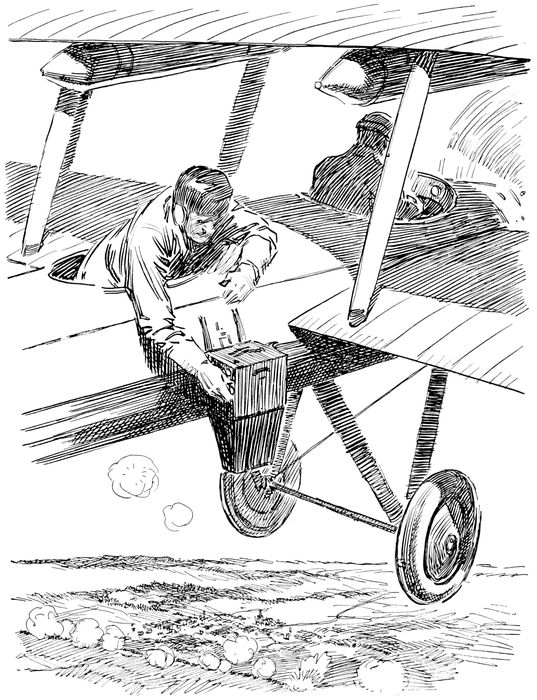
AVIATORS TAKING PHOTOGRAPHS
“An aviator’s most important duties are to take photographs of the enemy’s location and direct artillery fire. The aviator must seek out the enemy and learn their exact position. He must discover, if he can, about how many men and guns they have; how well they are fortified; how hard or easy it is to attack them. He makes many photographs and sketches which are valuable to his officers in planning an attack.”
“You haven’t told us how the brave aviator directs artillery fire,” broke in Tom.
“I’m getting to that now,” said Uncle Sam. “You know that there was a time when a man who fired a cannon could see his target. But now, a cannon, or the artillery, fires at a range of from six to thirty miles. No matter how big the target, it is impossible to see it from such a distance, especially when trees, mountains or fogs are in the way. Firing artillery is now a matter of calculation. Just where to shoot has to be figured out by means of maps, instruments, and mathematics. Quite often the figuring is not exactly right. The aviator must go up—bombs and shells bursting all around him—and discover if the guns are hitting the mark. When a shot doesn’t strike in the right place, the aviator sends directions by wireless for firing the next shell so that it will hit the enemy’s position and destroy it.

SCOUTING OVER THE RUINED REGION BETWEEN THE LINES (NO MAN’S LAND)
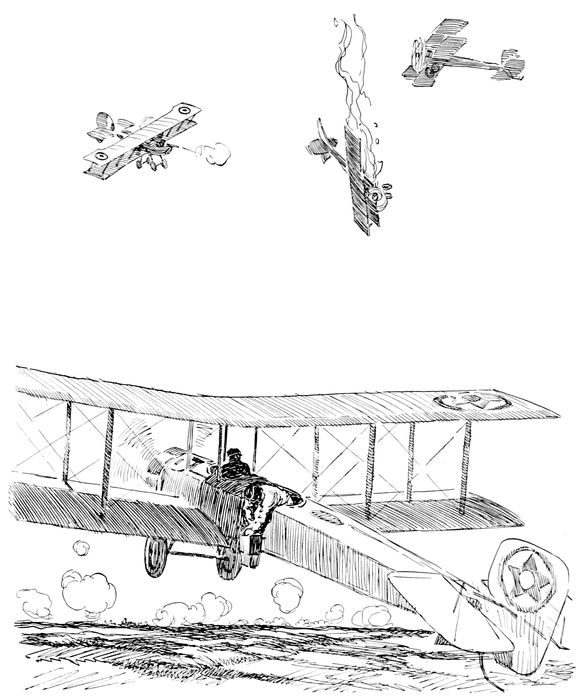
BATTLEPLANES CONVOYING PHOTOGRAPHING AEROPLANES
“Not all the excitement is over the battle lines. One of the most thrilling experiences an aviator can have is to fight off enemy aeroplanes and Zeppelins when they come to drop bombs on a city or town. Cities liable to be raided by hostile machines are protected by lookout towers. As soon as the Zeppelins are sighted, the men in the towers toot shrill blasts on loud siren horns. At the signal of the horns every light in the attacked city is put out, and all the people rush into houses and cellars for safety. Big anti-Zeppelin guns are pointed skyward to fire destruction-dealing shells at the enemy overhead.
“The brave aviators, who protect the city, start their machines and go up in the air to drive off the foe—amid the reek of fire and the scream of shot and shell. The battle is usually short. The swift defending aeroplanes, with their machine guns constantly spitting bullets, fight rings around the Zeppelins. The big guns on the ground send deadly missiles through many of the enemy airships. All of a sudden one bursts into flames. With a roar and a bang it hurtles to the earth. In the next moment, still another is hit. One of the doomed men saves himself by dropping off in a huge floating parachute. He is made prisoner the minute he touches ground.

FIGHTING ZEPPELIN RAIDERS
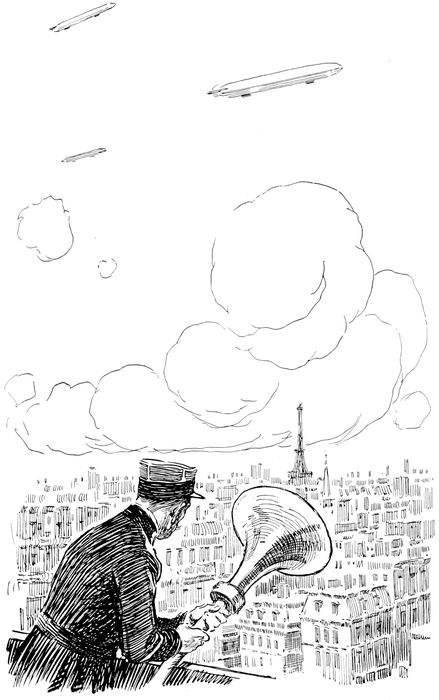
TOOTING THE SIRENS OF WARNING
“In a little while the remnant of the once-proud enemy air fleet flees in mortal terror. The day is saved. The heroic aviators, who successfully defended the city, return to earth amid the cheers of the grateful people.
“Usually the damage done is unimportant from a military point of view. Several non-combatants are killed and a few houses and an occasional church are damaged.
“Now, we will go back to the firing line, and see how the aeroplane is used in connection with the land fighting.
“Many German aeroplanes come to grief by trying to battle British tanks.”
“What’s a British tank?” put in Jack.
“I thought everyone was familiar with the tank, but as you evidently are not, I shall explain what it is. A tank is a great big battle car, protected with heavy shot-proof steel and armed with guns. It can travel anywhere—over hills, walls, trenches, through mud, bushes, and trees. Many people call a tank a land-battleship.
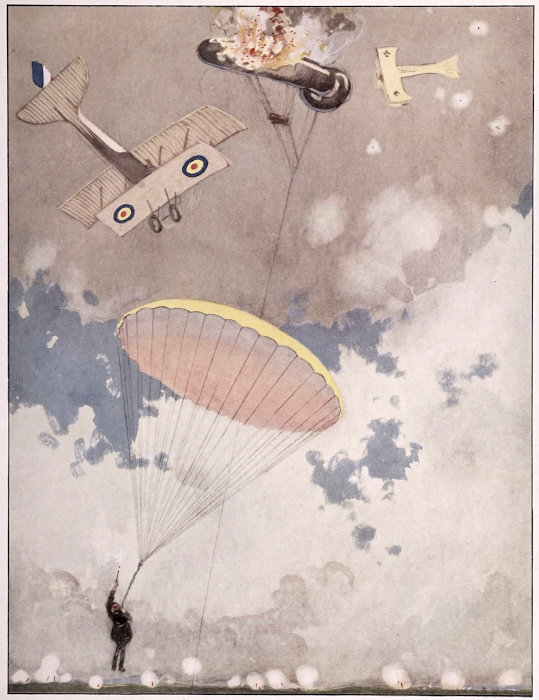
DROPPING OFF IN PARACHUTE FROM FLAMING BALLOON

BATTLE BETWEEN AEROPLANE AND BRITISH TANK
“Now that you know what a tank is, I will go on with my story. When the British attack the Germans, they often use tanks, which rumble along, crushing everything before them. The enemy forces are driven back in terror. In reckless despair they try to save the day by pitting their aeroplanes against these unbeatable steel monsters.
“Aeroplanes fighting British tanks are practically helpless and seldom attack them. ‘Zip! Zip! Bang!’ go the machine guns of the hostile aeroplanes. But the rain of shot and shell rattles harmlessly against the huge armored tanks. ‘Boom! Bang!’ roar the tanks’ heavy guns. Down drops one enemy aeroplane, in a horrible wake of flames and exploding gasoline. It strikes the earth—a shattered tangle of wire and wood. The aviator, of course, is dashed to death. Another of the foe’s machines is struck; and still another. All meet the same fate. Nothing can resist the tanks.”
“Such battles must be more exciting than fairy tales and novels,” exclaimed Tom and Jack in breathless wonder.
“There’s one thing our aviators do sometimes that is seldom excelled for courage and daring,” said Uncle Sam, pleased with the way his nephews were enjoying his story. “The enemy soldiers are very strongly entrenched behind earthworks and barbed wire fences. When our infantry find it impossible to make them flee, our bold aviators are assigned to the task.
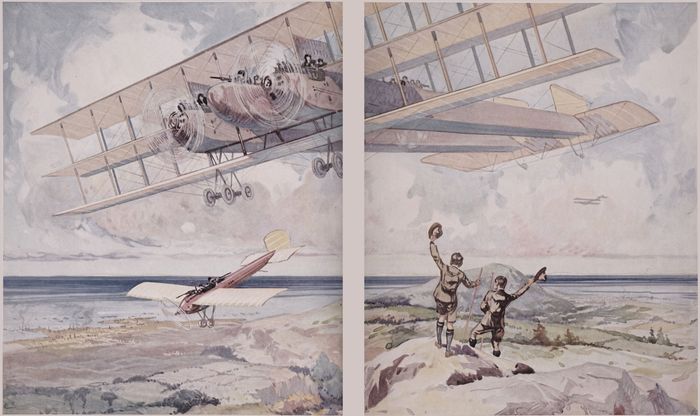
THE AGE OF FLYING
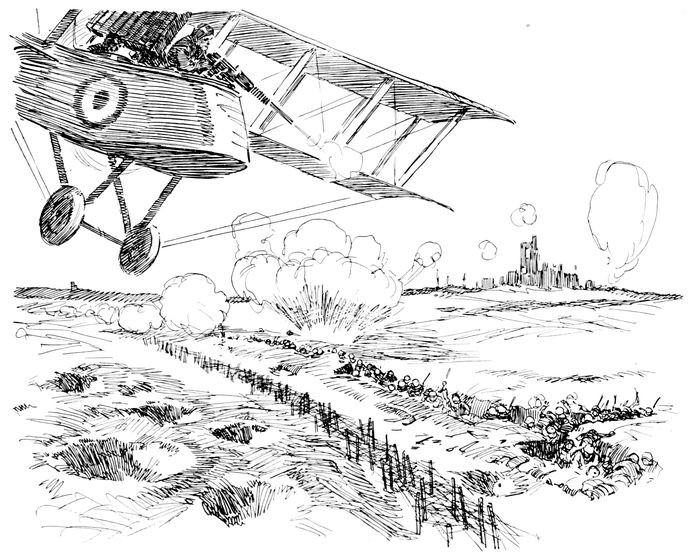
THEY SWOOP DOWN OVER THE TRENCHES
“With dash and bravery they go up in the air and hover near the hostile positions. Suddenly, like eagles they swoop down over the trenches shooting at the frightened enemy. ‘Zip! Crack! Bang!’ rattle their machine guns. Those who are not killed or seriously wounded flee in terror into the dugouts for safety.
“Then, quick as a flash, our men rush in and capture the trench before enemy reinforcements come up. The courageous aviators are wildly cheered but haven’t time now to listen to the praise; they must go up in the air again to protect their comrades from enemy aeroplanes, which lurk everywhere waiting for a chance to drop bombs.”
“By the way, Uncle Sam,” asked Jack, “why do aviators wear such heavy clothing?”
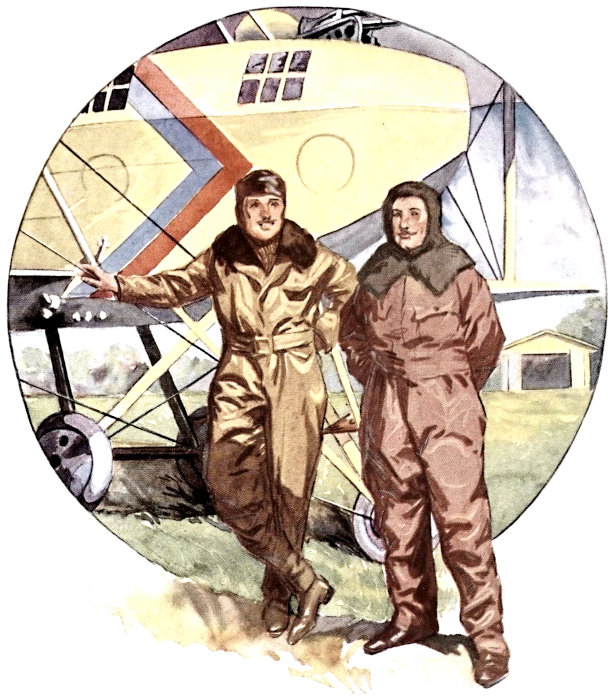
JUST BEFORE THE BATTLE
“It must be very cold up in the air,” thought Tom to himself, not saying anything for the first time.
“It’s frightfully cold up above the clouds,” said Uncle Sam. “The higher you fly the colder it becomes. Up in the sky, I have often felt a temperature below zero, while down on the earth it was comfortable and warm. Later on in school, you boys will learn that the sun’s rays give very little heat until they reach the earth. I would explain the reason myself, but I want to go on with the story.
“Our aviators are flying around in the sky about three miles above the earth when, all at once, the enemy’s machines dash into view. The two hostile air fleets see each other almost at the same time, and quickly prepare for action. A thrilling battle in the air is at hand.
“Our machines are outnumbered, but that does not deter us. ‘Rat-a-tat-tat,’ shrieks one of our machine guns. One of the foe is put out of action. His machine in flames, he falls dizzily to earth. Marvelous flying is now going on. One of our men loops-the-loop to get into position. An enemy aviator backs up his machine in mid-air: then dives down headlong a thousand feet. Swiftly he rights himself and speeds up firing right, left, and straight ahead. We have a hard time dodging that dangerous fellow.
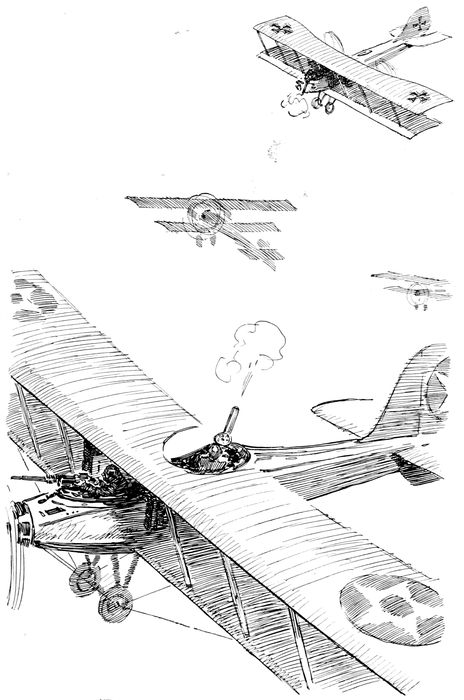
WE POUNCE ON THE BIG ENEMY BATTLEPLANE
“A big enemy battleplane gets separated from the group. In just two seconds two of our force pounce upon it. The huge machine battles skillfully for a while. Then we force it into a bad position, and rain upon it a terrible storm of bullets from our machine guns. The big battleplane goes down, but fighting to the last.
“Night approaches and envelops the earth with a blanket of darkness. Powerful searchlights from below, each of which is a wonderful instrument, scan the heavens with beams of ghostly white and yellow. The aeroplanes still struggle. The constant flashes from the bursting shells are even more terrible than in the day time. The scene is still more hideous when an unfortunate aviator takes the fatal plunge, his machine ablaze. One of our fine biplanes makes a mistake and gets right in line with an enemy’s gun. The foe’s machine-gun bullets penetrate its gasoline tank. It explodes in mid-air, and the biplane rushes to earth in a roaring blaze.”
“Who wins this great battle?” broke in Tom.
“Well, I’m getting to that now,” said Uncle Sam.
“Tom, you ought to be ashamed of yourself. You have done nothing but interrupt during the whole story,” declared Jack.
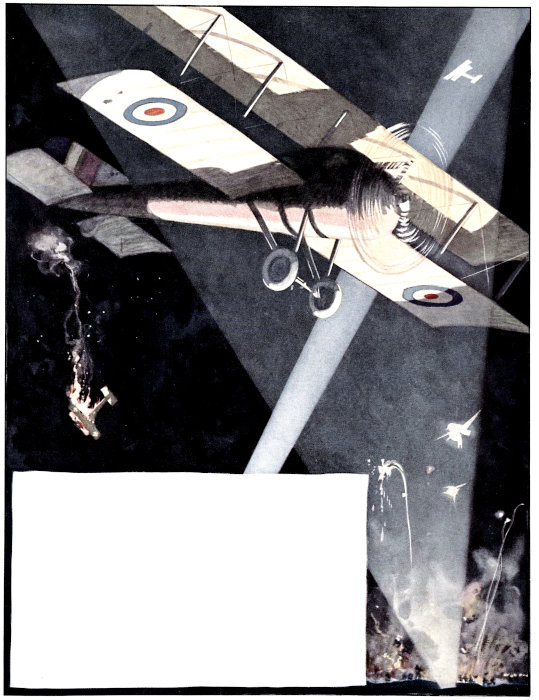
THE BATTLEPLANES STRUGGLE IN THE NIGHT
“Now, don’t you boys start quarreling. You might get in a worse scrape than the aeroplanes I’m telling about.
“Now I’ll get back to my story again:
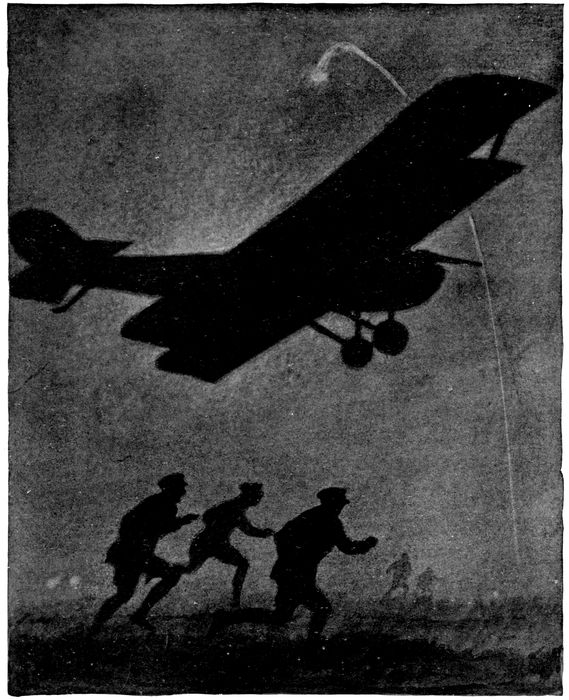
A SAFE LANDING SPOT
“Between nine and ten o’clock, the two rival air fleets are equally tired of the strife. Almost at the same time, both decide to stop fighting, and withdraw to their own sides of the battleline. The struggle itself might be called a tie. But since we kept the enemy from dropping bombs on our men in the trenches, the victory is really ours.
“It is dangerous for our airmen to land their machines in the dark. They might land on bad ground or in a tree, or possibly collide with some building. To make landing at night safe and avoid being seen by the enemy, was a problem we had to solve. We placed powerful electric lights deep in the ground and covered them with heavy glasses to prevent their breaking. When the lights are sunk in this manner they can be seen only from above. Wherever our aviators see one of these lights, they know it marks a safe landing spot.
“Now,” said Uncle Sam, “so far as our story is concerned we shall leave the bloody battlefront, and I will tell you about the aeroplane of the sea. The flying machine of the sea is called the hydroaeroplane. That is a rather long name. Seaplane is an easier word to pronounce, and is more commonly used. The seaplane can float like a boat and fly like an aeroplane.

THE SEAPLANE CAN SAIL ON THE WATER LIKE A BOAT AND FLY IN THE AIR LIKE AN AEROPLANE
“I suppose you boys have the same opinion of seaplanes as most people. You think the seaplane is not half as important as the land battleplanes I’ve been telling you about.”

THE BLIMP DIRIGIBLE BALLOON
“That’s right,” agreed Tom and Jack.
“Well,” continued Uncle Sam with an air of superior wisdom, “the aviation service of the sea is just as important as that of the land. As the land aeroplanes are the ‘eyes’ of the army, so the seaplanes are the ‘eyes’ of the navy. If it weren’t for these marvelous flying boats, the German submarines might have succeeded in sinking nearly all of our merchant ships—the boats that carry food, clothing, guns, and ammunition to the Allies of Democracy. Sometimes, too, our seaplanes have helped the battleships to destroy the enemy fleet.
“Just after the World War started, Germany launched her U-Boat submarines and undertook a campaign which eventually brought this country into the war. England was in a dreadful fix. Very little food, clothing, and munitions could get in from America; many of her fine ships were being sent to the bottom of the sea. There was no way to stop the U-Boats. What could we do?
“In these hours of trial, a smart Englishman invented a motor-driven balloon called a Blimp. It’s a mystery to me why they named it a Blimp. But, even with such a modern name, the Blimp could certainly scout for German submarines—the U-Boats. Whenever a Blimp found a U-Boat it would send a wireless message to a ship called a Submarine Destroyer which would chase the submarine and sink it.”
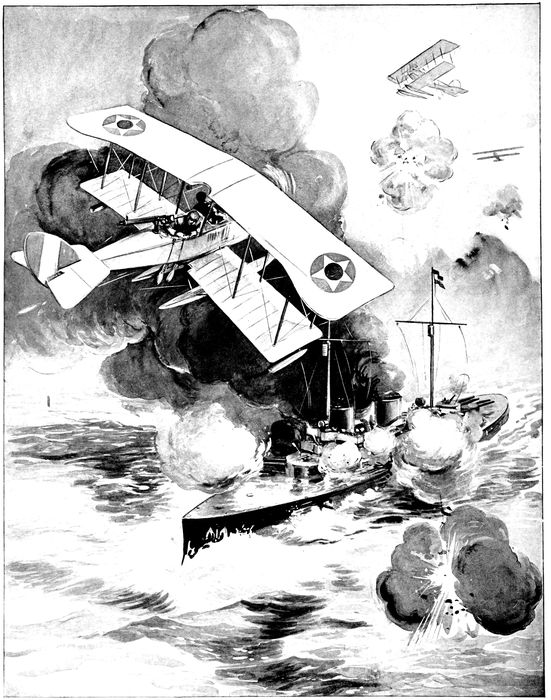
A GREAT BATTLE IN WHICH THE AMAZING AIR FLEETS OF THE SEA TAKE PART

BOMB SPLITS ZEPPELIN IN HALF
“What I can’t understand,” said Tom thoughtfully, “is why they need a Blimp or an aeroplane to find U-Boats? Why can’t the Submarine Destroyers seek out the U-Boats for themselves?”
“Yes, Uncle Sam, please explain that,” said Jack.
“I’ll gladly tell you the reason,” said Uncle Sam. “You know that you can’t see through a window from the outside when the sun shines on it. It is the same on the sea. When the light shines on the water, it is impossible to see beneath the waves. But when an aviator is high overhead the light is not reflected in his eyes. Therefore, he is able to see twenty, thirty, and, sometimes, a hundred feet under the surface of the water. Furthermore, a man high in the air can look around and see more than the man below.
“Now, I’ll start where I left off. I shall have to hurry along, as it is getting late. Since the early days of the great World War, many new inventions have made sea flying the marvel of the age. Suppose I tell you boys of a great battle in which the amazing air fleets of the sea take part.
“Two hostile fleets of warships steam defiantly toward each other. How proudly their banners flaunt gay colors in the breeze! How boldly their stately bows plough through the sea! How grim, how stern their gray sides reflect the sunlight! Ere the day is over, many, many ships of these grand fleets will lie on the ocean floor. Many others will stagger to home ports—battered wrecks.
“High over the enemy fleet are their Zeppelins, floating lazily with the clouds. Over our warships, darting here and there, are the ‘eyes’ of the fleet—our seaplanes. It won’t be long before the Zeppelins, the hostile aeroplanes, and our seaplanes are clinched in a struggle to death.
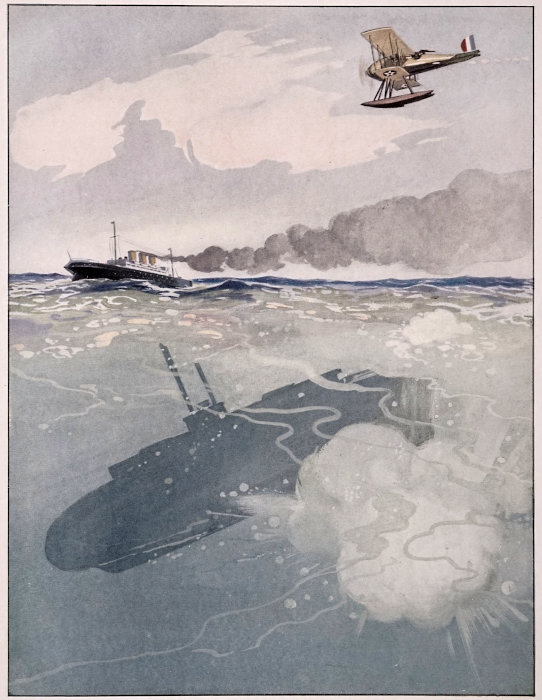
THE DEPTH BOMB DESTROYS A U-BOAT

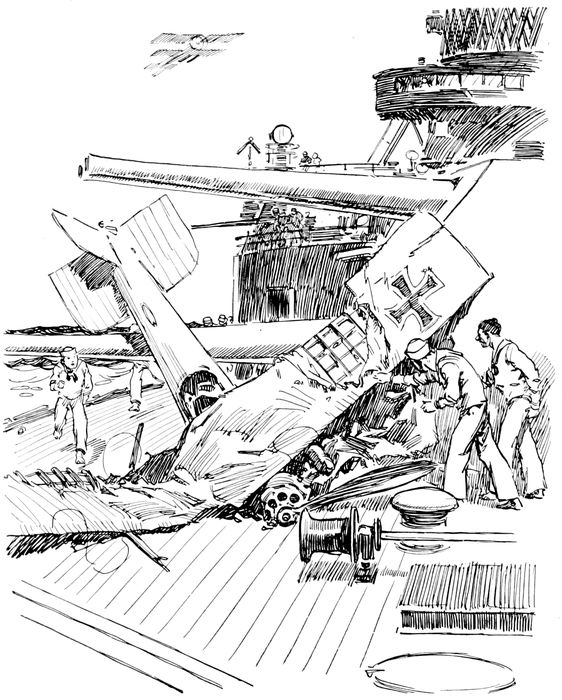
A MASS OF WRECKAGE THAT STRIKES THE DECK OF ONE OF OUR WARSHIPS
“Let us look at the battleships again. Many of them carry small elevated railways on which run tiny cars. These are called seaplane catapults. The word catapult means, ‘To throw heavy stones.’ So we conclude that these little railways throw seaplanes. Well, they do throw seaplanes. Let’s inspect one and see how it is done. The little car, bearing a big seaplane, with its propeller spinning, shoots along the railway track at lightning speed. At the very end, it strikes a bumper. Off shoots the seaplane. The car darts back to the starting point. When a battleship clears for action, the catapult is taken down.
“The monster warships have now begun to fight. Their big guns are banging and booming—hundreds of times louder than thunder. On the decks, behind the guns, in the engine rooms and wireless cabins—everywhere, men are striving, straining every nerve, risking their lives for the land they love.
“It’s aviation we are talking about, so let’s look high overhead. Our marvelous seaplanes are spying on the hostile battleships, fighting the Zeppelins and enemy aeroplanes, and dropping bombs on the foe below—all at the same time. ‘Rat-a-tat-tat,’ shrieks a seaplane’s deadly machine gun. With a sickening plunge, an enemy aeroplane darts down—a streak of flaming wood and tangled metal. Down goes another—a mass of wreckage that strikes the deck of one of our warships. A daring aviator dashes up, up, away up in the air; and drops a bomb on a Zeppelin. Right in the middle strikes the missile of destruction. The enemy’s cigar-shaped airship makes a headlong dive for the ocean—split in half. It strikes the bosom of the sea; and disappears in one final, deafening explosion, which throws the salt spray high into the air.
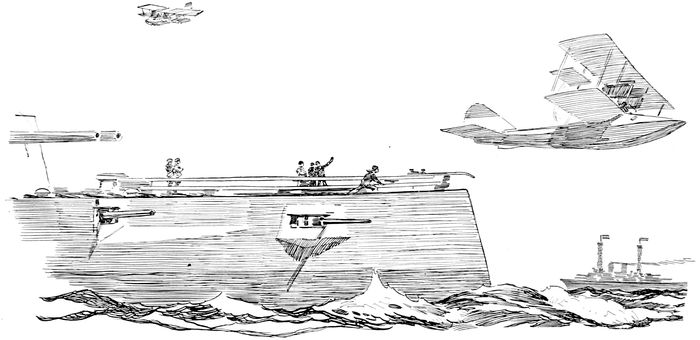
THE SEAPLANE SHOOTS OFF THE CATAPULT
“Let’s get a glimpse of another part of the battle scene. One of our seaplanes is flying along at a moderate rate of speed, when the tell-tale periscope is sighted. A U-Boat is near the surface of the water. Our aviator drops a remarkable, a terrific bomb. When this bomb sinks deep enough, the pressure of the water makes it explode. The force of the underwater explosion causes anything near it to be crushed like an egg shell. You can imagine what happens to the unfortunate submarine.
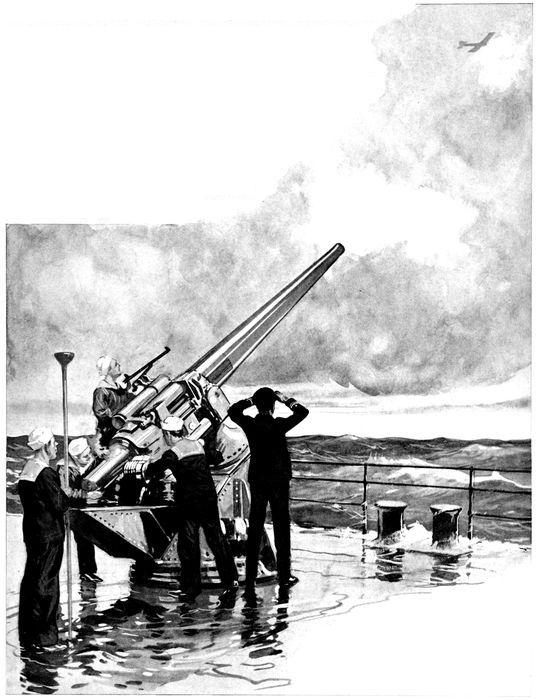
SENDING UP A “HUMMING” SHOT A LITTLE TOO CLOSE FOR COMFORT
“All of a sudden, three enemy aeroplanes dash into view, determined to attack our seaplane—to avenge the sunken U-Boat. But when one of the big guns on our warship sends up a ‘humming’ shot, a little too close to the foe for comfort, they withdraw at once.
“We finally won this dreadful sea battle, and the seaplanes certainly deserve a great deal of credit.
“If you boys have followed my story, you know the value of land and sea aviation service in time of war.”
“Indeed, I have followed it,” said Tom warmly.
“It’s the most interesting tale I ever heard or read,” exclaimed Jack.
“Listen to me, boys,” said their Uncle Sam. He was a bit annoyed and impatient; for he now had little time to spare for interruptions.
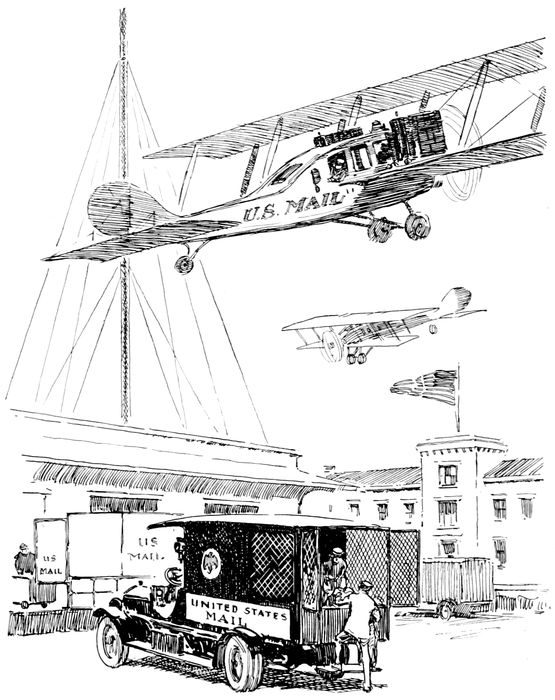
FAST MAIL-CARRYING AEROPLANES WILL MAKE POSTAL DELIVERIES EVERYWHERE
“The greatest benefit from the ‘Conquest of the Air’ will come in times of peace. Before I go, I shall tell you boys a few of the peace-time uses of the land aeroplane, the hydroaeroplane or seaplane, the Zeppelin, the Blimp, the ordinary balloon—all the mechanical birds of Man’s inventive genius. Some of these uses you are already familiar with; some you and I will live to see; some won’t come to pass until we are in our graves.
“The greatest aviation service will likely be transportation, both for business and pleasure. Aeroplanes and motor-driven balloons will rival steamships, trains, and automobiles as carriers of passengers, freight, and mail. There will be big aerial ocean liners plying over the Atlantic and, possibly, the wide Pacific. Fast mail-carrying aeroplanes, capable of a speed of two or more miles a minute, will make postal deliveries everywhere. Letters from New York will reach Chicago in a few hours. Private aeroplanes, darting here and there among the clouds, will be as numerous as the birds. Thousands of seaplanes will sail on and glide over our lakes, rivers, bays, and oceans.

CAPRONI TRIPLANE CROSSING THE ALPS
“Aerial transportation is not just a thing of the future. It is already here. In May, 1918, regular aeroplane mail service was begun between New York City and Washington, D. C. Many men now have their own aeroplanes or seaplanes, and travel around in them as commonly as in an automobile. Two brave Italians flew, in a trifle over seven hours, from Turin, Italy, across the Alps and then to London—a distance of 650 miles. A gigantic aeroplane has been invented in Italy. It is called the Caproni Triplane, because a man named Caproni invented it, and because it bears three sets of planes or wings. It is able to travel a long distance and carry heavy loads.

SHIP SAVED BY LIFE LINE THROWN FROM A RESCUE AIRSHIP
“Outside of transportation, there are and will be numerous other peace-time uses for aeroplanes and balloons. But I have time to tell about only two more—ship saving and aerial weather observation. Many a ship stranded on the rocks in a storm can be reached by a life line thrown from a rescue airship. An aviator high in the sky can find out weather conditions not known on the earth below. From his reports, we shall be able to make more accurate weather forecasts.
“Well, boys,” said Uncle Sam, “my aviation story is over, and I must be on my way.”
He gives each boy a warm handshake, and bids good-bye. He jumps into his aeroplane, and starts the motor. The propellers whirl. The noise of the motor is deafening. Finally, the big bird skims the ground and gracefully ascends.

A beautiful landscape closes the scene. The sun, in a halo of golden glory, sinks in the west. Uncle Sam in his aeroplane is a mere speck in the lonely twilight sky. The boys watch him float out of sight, and then start for home with their minds full of aeroplanes, balloons, aviators, aviation.
